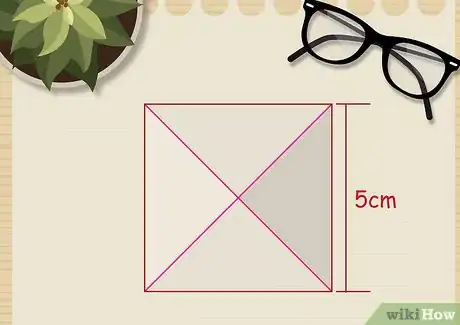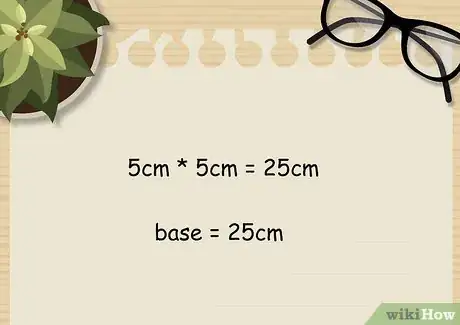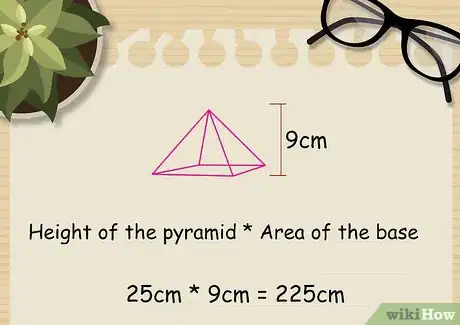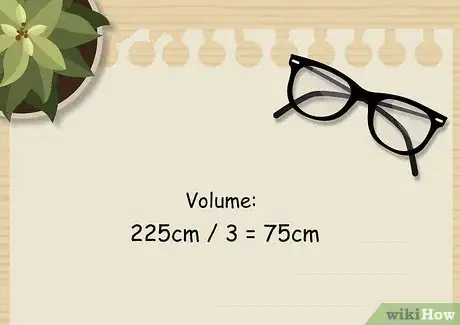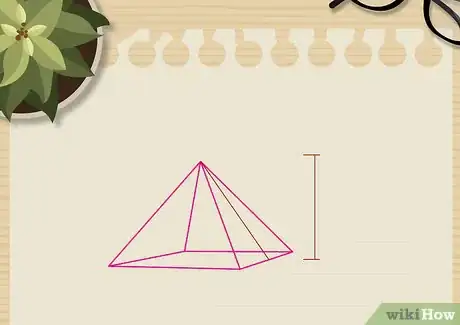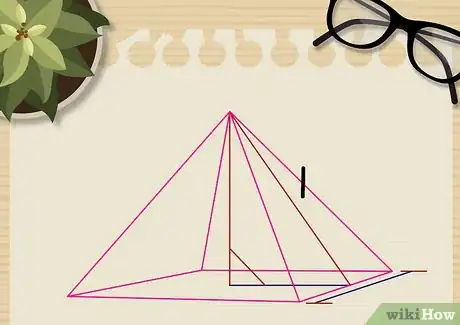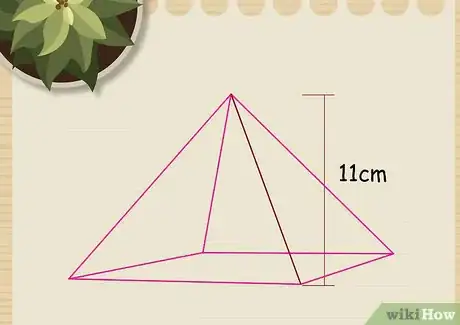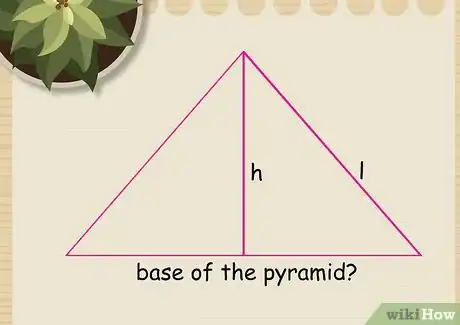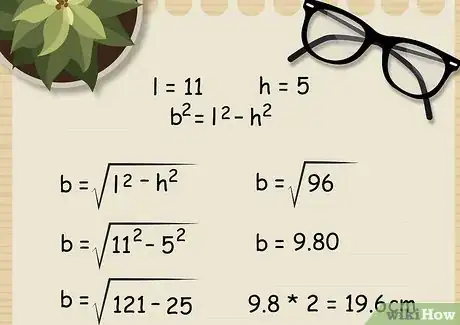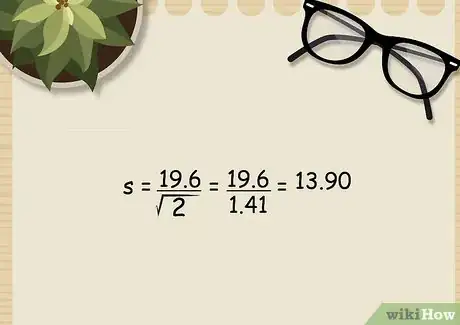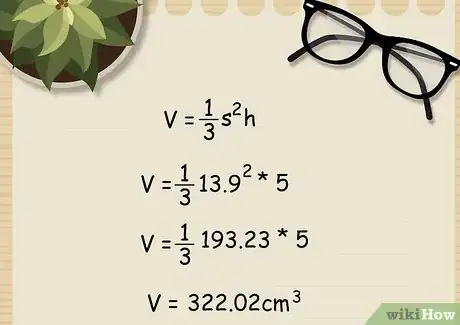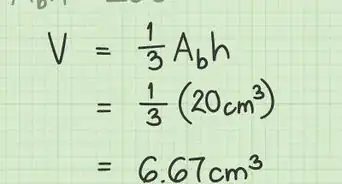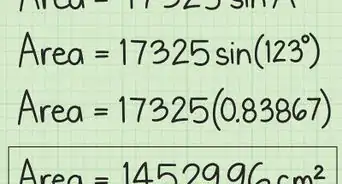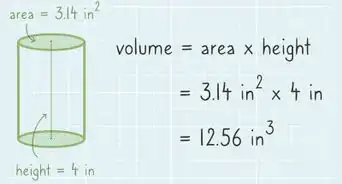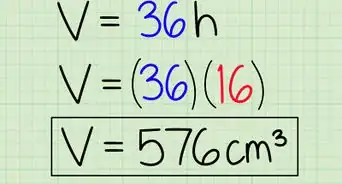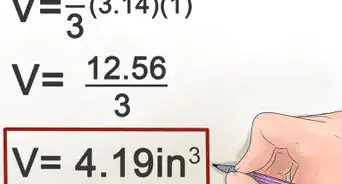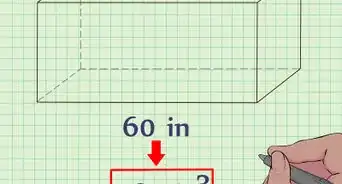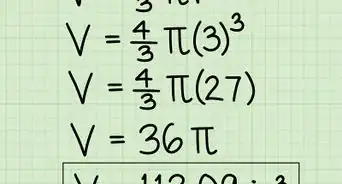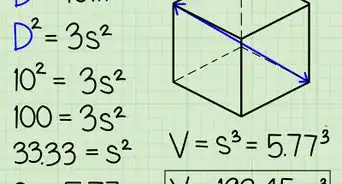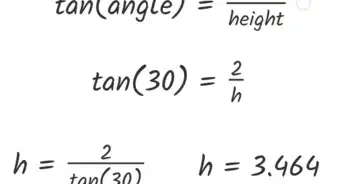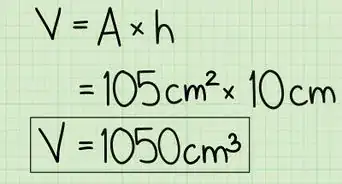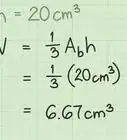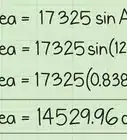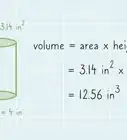This article was co-authored by wikiHow Staff. Our trained team of editors and researchers validate articles for accuracy and comprehensiveness. wikiHow's Content Management Team carefully monitors the work from our editorial staff to ensure that each article is backed by trusted research and meets our high quality standards.
This article has been viewed 375,176 times.
Learn more...
A square pyramid is a three-dimensional solid characterized by a square base and sloping triangular sides that meet at a single point above the base. If represents the length of one of the square base's sides and represents the height of the pyramid (the perpendicular distance from the base to the point), the volume of a square pyramid can be calculated with the formula . It doesn't matter whether the pyramid is the size of a paperweight or larger than the Great Pyramid of Giza - this formula works for any square pyramid. The volume can also be calculated using what is called the “slant height” of the pyramid.
Steps
Finding Volume Using Base Area and Height
-
1Measure the side length of the base. Since, by definition, square pyramids have bases that are perfectly square, all of the sides of the base should be equal in length. Thus, for a square pyramid, you only need to find the length of one side.[1]
- Consider a pyramid whose base is a square with side lengths of . This is the value you will use to find the area of the base.
- If the sides of the base are not equal in length, you have a rectangular pyramid rather than a square pyramid. The volume formula for rectangular pyramids is very similar to the formula for square pyramids. If represents the length of the rectangular pyramid's base and represents its width, the pyramid's volume is .
-
2Calculate the area of the base. Finding the volume begins by finding the two-dimensional area of the base. This is done by multiplying the base's length times its width. Because the base of a square pyramid is a square, its sides all have equal lengths, so the area of the base is equal to the length of one side squared (times itself).[2]
- In the example, since the side lengths of the pyramid's base are all 5 cm, you can find the base's area as:
- Remember that two-dimensional areas are expressed in square units - square centimeters, square meters, square miles, and so on.
Advertisement - In the example, since the side lengths of the pyramid's base are all 5 cm, you can find the base's area as:
-
3Multiply the area of the base by the pyramid's height. Next, multiply the base area by the height of the pyramid. As a reminder, the height is the distance of the line segment stretching from the apex of the pyramid to the plane of the base at perpendicular angles to both.[3]
- In the example, suppose the pyramid has a height of 9 cm. In this case, multiply the area of the base by this value as follows:
- Remember that volumes are expressed in cubic units. In this case, because all the linear measurements are centimeters, the volume is in cubic centimeters.
- In the example, suppose the pyramid has a height of 9 cm. In this case, multiply the area of the base by this value as follows:
-
4Divide this answer by 3. Finally, find the volume of the pyramid by dividing the value you just found from multiplying the base area by the height by 3. This will give you a final answer that represents the volume of the square pyramid.[4]
- In the example, divide 225 cm3 by 3 to get an answer of 75 cm3 for the volume.
Finding Volume Using Slant Height
-
1Measure the pyramid's slant height. Sometimes you will not be told the perpendicular height of the pyramid. Instead, you may be told - or may have to measure - the pyramid’s slant height. With the slant height, you will be able to use the Pythagorean Theorem to calculate the perpendicular height.[5]
- A pyramid's slant height is the distance from its apex to the midpoint of one of the base sides. Measure to the midpoint of the side and not to one of the corners of the base. For this example, assume that you measure the slant height to be 13 cm, and you are told that the side length is 10 cm.
- As a reminder, the Pythagorean Theorem can be expressed as the equation , where and are the perpendicular legs of the right triangle and is the hypotenuse.
-
2Imagine a right triangle. To use the Pythagorean Theorem, you need a right triangle. Imagine a right triangle slicing through the middle of the pyramid and perpendicular to the base of the pyramid. The slant height of the pyramid, called , is the hypotenuse of this right triangle. The base of this right triangle is one half the length of , the side of the square base of the pyramid.[6]
-
3Assign variables to the values. The Pythagorean Theorem uses the variables a, b, and c, but it helps to replace those with variables that have meaning for your problem. The slant height takes the place of in the Pythagorean Theorem. The leg of the right triangle, which is , takes the place of You will be solving for the height of the pyramid, , which takes the place of in the Pythagorean Theorem.[7]
- This substitution will look like this:
- This substitution will look like this:
-
4Use the Pythagorean Theorem to calculate the perpendicular height. Insert the measured values of and . Then proceed to solve the equation:[8]
- .....(original equation)
- .....(square root both sides)
- .....(substitute values)
- .....(simplify fraction)
- .....(simplify square)
- .....(subtract)
- .....(simplify square root)
-
5Use the height and base to calculate volume. After using the calculations with the Pythagorean Theorem, you now have the information you need to calculate the volume of the pyramid as you normally would. Use the formula and solve, making sure to label your answer in cubic units.[9]
- From the calculations, the height of the pyramid is 12 cm. Use this and the base side of 10 cm. to calculate the pyramid's volume:
- From the calculations, the height of the pyramid is 12 cm. Use this and the base side of 10 cm. to calculate the pyramid's volume:
Finding Volume Using the Edge Height
-
1Measure the pyramid’s edge height. The edge height is the length of the edge of the pyramid, measured from the apex to one of the corners of the pyramid’s base. As before, you will then use the Pythagorean Theorem to calculate the perpendicular height of the pyramid.[10]
- For this example, assume that the edge height can be measured to be 11 cm and you are given that the perpendicular height is 5 cm.
-
2Imagine a right triangle. As before, you need a right triangle to use the Pythagorean Theorem. In this case, however, your unknown value is the base of the pyramid. You know the perpendicular height and the edge height. If you imagine cutting the pyramid diagonally from one corner to the opposite corner and opening it up, the exposed inside face is a triangle. The height of that triangle is the perpendicular height of the pyramid. It divides the exposed triangle into two symmetrical right triangles. The hypotenuse of either right triangle is the edge height of the pyramid. The base of either right triangle is one-half the diagonal of the base of the pyramid.
-
3Assign variables. Use this imaginary right triangle and assign values to the Pythagorean Theorem. You know the perpendicular height, which is one leg of the Pythagorean Theorem, . The edge height of the pyramid, is the hypotenuse of this imaginary right triangle, so it takes the place of . The unknown diagonal of the base of the pyramid is the remaining leg of the right triangle, After you make these substitutions, the equation will look like this:
-
4Calculate the diagonal of the square base. You will need to rearrange the equation to isolate the variable and then solve for its value.[11]
- ..........(revised equation)
- ..........(substitute h2 from both sides)
- ..........(square root both sides)
- ..........(insert numerical values)
- ..........(simplify squares)
- ..........(subtract values)
- ..........(simplify square root)
- Double this value to find the diagonal of the square base of the pyramid. Thus, the diagonal of the pyramid’s base is 9.8*2=19.6 cm.
-
5Find the side of the base from the diagonal. The base of the pyramid is a square. The diagonal of any square is equal to the length of a side times the square root of 2. Conversely, you can find the side of the square from its diagonal by dividing by the square root of 2.[12]
- For this sample pyramid, the diagonal has been calculated to be 19.6 cm. Therefore, the side is equal to:
- For this sample pyramid, the diagonal has been calculated to be 19.6 cm. Therefore, the side is equal to:
-
6Use the side and height to calculate volume. Return to the original formula to calculate the volume using the side and perpendicular height.[13]
Community Q&A
-
QuestionIf I have only the volume, how do I solve for height?
 DonaganTop AnswererYou cannot solve for height if all you know is the volume.
DonaganTop AnswererYou cannot solve for height if all you know is the volume. -
QuestionIn method 1, why did you divide 225 by 3?
 DonaganTop AnswererBecause that's the formula for the volume: one-third of the product of the base area and the height.
DonaganTop AnswererBecause that's the formula for the volume: one-third of the product of the base area and the height. -
QuestionHow do I find length?
 DonaganTop AnswererTo find the length of one side of the square base, you must know the height and the volume of the pyramid. To get the length, multiply the volume by three, divide that by the height, and then take that number and find its square root.
DonaganTop AnswererTo find the length of one side of the square base, you must know the height and the volume of the pyramid. To get the length, multiply the volume by three, divide that by the height, and then take that number and find its square root.
References
- ↑ https://www.cuemath.com/measurement/volume-of-a-square-pyramid/
- ↑ https://www.omnicalculator.com/math/square-pyramid-volume
- ↑ https://www.cuemath.com/measurement/volume-of-a-square-pyramid/
- ↑ https://www.omnicalculator.com/math/square-pyramid-volume
- ↑ http://mathworld.wolfram.com/SquarePyramid.html
- ↑ http://mathworld.wolfram.com/SquarePyramid.html
- ↑ https://www.chino.k12.ca.us/cms/lib/CA01902308/Centricity/Domain/4926/12-5_Volumes_of_Pyramids_and_Cones.pdf
- ↑ https://www.pbte.edu.pk/text%20books/dae/math_113/Chapter_17.pdf
- ↑ http://mathworld.wolfram.com/SquarePyramid.html
- ↑ http://www.bbc.co.uk/schools/gcsebitesize/maths/geometry/pythagoras3drev1.shtml
- ↑ http://www.bbc.co.uk/schools/gcsebitesize/maths/geometry/pythagoras3drev1.shtml
- ↑ http://www.bbc.co.uk/schools/gcsebitesize/maths/geometry/pythagoras3drev1.shtml
- ↑ http://www.bbc.co.uk/schools/gcsebitesize/maths/geometry/pythagoras3drev1.shtml
About This Article
To calculate the volume of a square pyramid, first find the length of one of the sides of the base of the pyramid. Then, calculate the area of the base by squaring the length of the side, and multiply the area by the pyramid’s height. Finally, divide the answer by 3 to find the volume of the square pyramid, and write your answer in units cubed. For tips on finding the volume using slant height or height edge, scroll down!



